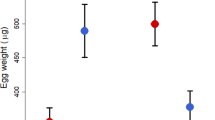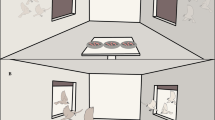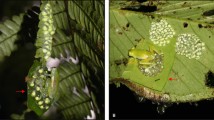Abstract
The origin and maintenance of eusociality is a central problem in evolutionary biology1,2. Eusocial groups contain individuals that forfeit their own reproduction in order to help others reproduce. In facultatively eusocial taxa, offspring can choose whether to found new nests or become helpers in their natal groups. In many facultatively eusocial insects, offspring need continuous care during development, but adult carers have life expectancies shorter than the developmental period3,4,5,6,7. When a lone foundress dies, her partly reared brood are usually doomed. Here, we show that helpers in a tropical hover wasp (Liostenogaster flavolineata) have an insurance-based advantage over lone foundresses because after a helper dies, most of the brood that she has partly reared will be brought to maturity by surviving nest-mates. After some of the helpers are experimentally removed from a multi-female nest, the reduced group is left with more brood than it would normally rear. We found that larger, more valuable extra brood were reared through to maturity, but not smaller, less valuable brood. Smaller brood may be sacrificed to feed larger brood, and reduced groups probably benefited from increased short-term helper recruitment. Rearing extra brood did not increase adult mortality or brood development time.
This is a preview of subscription content, access via your institution
Access options
Subscribe to this journal
Receive 51 print issues and online access
$199.00 per year
only $3.90 per issue
Buy this article
- Purchase on Springer Link
- Instant access to full article PDF
Prices may be subject to local taxes which are calculated during checkout



Similar content being viewed by others
References
Maynard Smith,J. & Szathmary,E. The Major Transitions In Evolution (W. H. Freeman, Oxford, 1995).
Hamilton,W. D. The genetical evolution of social behaviour. I and II. J. Theor. Biol. 7, 1–52 ( 1964).
Queller,D. C. in Natural History And Evolution Of Paper-Wasps (eds Turillazzi, S. & West-Eberhard, M. J.) 218–234 (Oxford Univ. Press, Oxford, 1996).
Queller,D. C. The evolution of eusociality: reproductive head starts of workers. Proc. Natl Acad. Sci. USA 86, 3224– 3226 (1989).
Gadagkar,R. Evolution of eusociality: the advantage of assured fitness returns. Phil. Trans. R. Soc. Lond. B 329, 17– 25 (1990).
Queller,D. C. Extended parental care and the origin of eusociality. Proc. R. Soc. Lond. B 256, 105–111 (1994).
Strassmann,J. E. & Queller,D. C. in The Genetics of Social Evolution (eds Breed, M. D. & Page, R. E.) 81– 101 (Westview, Boulder, Colorado, 1989).
Reeve,H. K. in The Social Biology of Wasps (eds Ross, K. G. & Matthews, R. W.) 99–148 (Cornell Univ. Press, Ithaca, 1991).
Turillazzi,S. in The Social Biology of Wasps (eds Ross, K. G. & Matthews, R. W.) 74–98 (Cornell Univ. Press, Ithaca, 1991).
Samuel,C. T. Factors Affecting Colony Size in the Stenogastrine Wasp Liostenogaster Flavolineata . PhD thesis, Univ. Malaya (1987).
Field,J. & Foster,W. Helping behaviour in facultatively eusocial hover wasps: an experimental test of the subfertility hypothesis. Anim. Behav. 57, 633–636 (1999).
Field,J., Shreeves,G. & Sumner, S. Group size, queuing and helping decisions in facultatively eusocial hover wasps. Behav. Ecol. Sociobiol. 45, 378–385 (1999).
Field,J., Foster,W., Shreeves,G. & Sumner,S. Ecological constraints on independent nesting in facultatively eusocial hover wasps. Proc. R. Soc. Lond. B 265, 973–977 (1998).
Nonacs,P. & Reeve,H. K. Opportunistic adoption of orphaned nests in paper wasps as an alternative reproductive strategy. Behav. Proc. 30, 47–60 ( 1993).
Gervet,J. La ponte et sa regulation dans la societe polygyne de Polistes gallicus . Annu. Sci. Nat. Zool. 6, 601– 778 (1964).
Mead,F., Habersetzer,C., Gabouriaut, D. & Gervet,J. Dynamics of colony development in the paper wasp Polistes dominulus Christ (Hymenoptera, Vespidae): the influence of prey availability. J. Ethol. 12, 43–51 ( 1994).
Hatchwell,B. J. & Davies,N. B. Provisioning of nestlings by dunnocks, Prunella modularis, in pairs and trios: compensation reactions by males and females. Behav. Ecol. Sociobiol. 27, 199–209 (1990).
Hatchwell,B. J. & Russell,A. F. Provisioning rules in cooperatively breeding long-tailed tits Aegithalos caudatus: an experimental study. Proc. R. Soc. Lond. B 263, 83–88 (1996).
Schmid-Hempel,P. Parasites in Social Insects (Princeton Univ. Press, New Jersey, 1998).
Reeve,H. K. & Nonacs,P. Within-group aggression and the value of group members: theory and a field test with social wasps. Behav. Ecol. 8, 75–82 ( 1997).
Kukuk,P. F. Ward,S. A. & Jozwiak, A. Mutualistic benefits generate an unequal distribution of risky activities among unrelated group members. Naturwissenschaften 85, 445–449 ( 1998).
Crawley,M. J. GLIM for Ecologists (Blackwell, Oxford, 1993).
Acknowledgements
We thank K. Durai, H. Rosli, A. Sofian and L. Kirton for their hospitality in Malaysia; A. Bolton, A. Bourke, M. Cant, W. Foster and I. Karsai for their comments on the manuscript; and the NERC for funding the research.
Author information
Authors and Affiliations
Rights and permissions
About this article
Cite this article
Field, J., Shreeves, G., Sumner, S. et al. Insurance-based advantage to helpers in a tropical hover wasp. Nature 404, 869–871 (2000). https://doi.org/10.1038/35009097
Received:
Accepted:
Issue Date:
DOI: https://doi.org/10.1038/35009097
This article is cited by
-
Split sex ratios and genetic relatedness in a primitively eusocial sweat bee
Behavioral Ecology and Sociobiology (2021)
-
Changes in maternal investment with climate moderate social behaviour in a facultatively social bee
Behavioral Ecology and Sociobiology (2018)
-
Effects of social organization and resource availability on brood parasitism in the facultatively social nocturnal bee Megalopta genalis
Insectes Sociaux (2018)
-
The evolution of simultaneous progressive provisioning revisited: extending the model to overlapping generations
Behavioral Ecology and Sociobiology (2017)
-
Interactions between the Social Digger Wasp, Cerceris rubida, and Its Brood Parasitic Flies at a Mediterranean Nest Aggregation
Journal of Insect Behavior (2017)
Comments
By submitting a comment you agree to abide by our Terms and Community Guidelines. If you find something abusive or that does not comply with our terms or guidelines please flag it as inappropriate.



